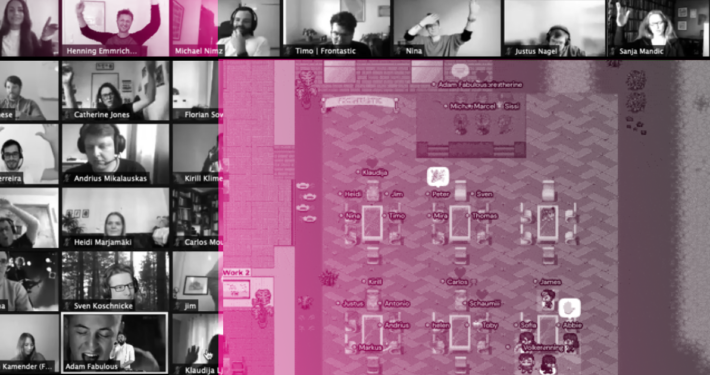The art of remote communication
Timo Pelster, Head of People and Collaboration @Frontastic
We’re a remote company. For us, the difference between synchronous and asynchronous communication isn’t just a methodological one. It’s a success-critical component of our company culture and our ways of working. In this blog post, we talk about the art of communication at Frontastic, and how we embrace the synchronous and asynchronous way of working together.
Embracing asynchronous communication
In none of my previous jobs did I learn as much about communication as I have at Frontastic. Again and again, I’ve experienced situations in remote work where I’d have preferred a synchronous rather than an asynchronous approach or the other way around. Communication is our connecting element, and it’s certainly a good idea to take a closer look at the pitfalls.
“A meaningful learning from my past 2.5 years in a remote environment is that we need to understand communication as part of our tool stack and use it as we use a tool.“
The desire for direct, synchronous exchange is great for many people and sometimes the more efficient way. But deep work and focus time are essential to the success of remote companies and should be part of a remote workers’ routine. What we need to achieve is a balance between synchronous and asynchronous communication that allows for speed as well as emotion and social bonding. At the same time, this approach needs to reinforce the benefits of remote work and be oriented towards value for the company.
When to choose synchronous, when to choose asynchronous
- Synchronous
- Emergencies
- Complex discussions
- Teem meetings
- All-hands meetings
- Retrospectives
- 1:1’s and small talks
- All-hands social activities and lunches
- Retreats and success celebrations
- Important company-wide announcements
- Asynchronous
- General discussions
- Collaboration on specific topics
- Alignments
- Planinngs
- Handovers
- Updates
- General announcements
- General feedback
- Catch-ups and approvals
In most cases, we manage to intuitively decide which form of communication is the best one. The list above already shows very specific occasions to exchange synchronously, while the non-specific list of asynchronous events suggests that this must be the default.
Yet, there are 2 major things that happen to us and other remote companies:
- We get lost in incredibly long threads on a topic that would be quickly resolved with a short synchronous conversation (see complex discussions, emergencies …).
- We book meetings, request spontaneous calls, or chase someone in the ‘virtual office,’ although an asynchronous way would be possible, efficient, and respect the autonomy of other people’s schedules.
There might be reasons why we choose to do so. If someone is synchronously unavailable, the long thread is unavoidable. Sometimes, there are situations and circumstances where we need more than a few lines of text and an emoji to convey what we mean. Occasionally, we need the synchronous exchange because it gives us a sense of togetherness or avoids misunderstandings that could lead to conflict.
All that is human, and it’s perfectly fine. But, we should always remember that we’re using a powerful tool, that we’re interfering with another person’s daily routine, that remote work can only come to full bloom if we understand asynchronous communication as our default.
How to use synchronous communication
Respect
As I mentioned before: a synchronous meeting — especially a spontaneous call or invitation — is an interruption in another person’s daily routine or planned schedule. We should take the above to heart and note when someone is consciously in focus time, consider when someone can’t or doesn’t want to be available for meetings, and appreciate that we take the time for each other when we speak synchronously.
Plan
Synchronous communication only succeeds if it’s well planned. With Remeet, we have a tool that allows us to get the most out of a synchronous meeting. We should always ask ourselves if people need to prepare. We should add an agenda to an appointment. We should be sure that it’s the right time and that there are no dependencies for actions and decisions needed ahead of the meeting.
Facilitate
Facilitation is the art of shaping a conversation efficiently and effectively, controlling the proportions of speech, and generating and documenting the greatest possible output. There’s no shame in relying on an external moderator (someone from another team) because you feel you won’t get the best result otherwise. This can be particularly useful for retrospectives, but a facilitator can also be a good choice for any other appointment.
Record
Sometimes it’s sufficient to discuss a topic in a small group if you know that other interested parties will have the opportunity to learn and contribute afterward. This is why we try to record all internal meetings and make them available (with English as a default for recorded sessions), and add notes to them. Giving as many people as possible the option to inform themselves transparently, without creating the need to have more meetings with other people to update them on what happened. This is something from which we as a remote company benefit greatly.
Improve
No matter how often I talk to our CEO Thomas or our Lead Editor Catherine in video calls, I’m always amazed by their video quality. Not all of us need the best setup, but an investment in quality, good exposure, and good sound should be an important issue for all of us. Our video connection is how we perceive each other, how we’re part of meetings. It doesn’t always work out great, and external circumstances can cause things to be less than optimal at times. Still, we should question our setup and ask our team if we successfully create a good atmosphere. This is one reason why we offer all people a budget for additional equipment next to the company laptop.
How to use asynchronous communication
Accessibility and organization
Asynchronous communication can only be successful if access to information (except for sensitive or private information) is ensured. Only then do we get to see what’s happening in and around the company. Only then do we have the chance to make our contribution. Only then can we avoid information being lost along the way. It’s everyone’s own responsibility to care for streamlining this information and to not get overwhelmed (leave or mute channels that aren’t of interest, change settings for notifications, overcome ‘fear of missing out’ knowing that this isn’t efficient, …).
Besides access, organization and structure is something that’s crucial. It makes sense to briefly consider what information belongs in Slack, in Notion, or in Jira, for example. Where this isn’t immediately clear, either structures need to be created or existing ones rethought.
Precision
Some time ago, I had an asynchronous conversation with our CEO Thomas that became significantly longer than it should’ve been. At the end of the thread, Thomas reflected and wrote to me: “We need to be more precise.”
Precise. At that moment, I realized again how enormously important it is in a remote situation we put ourselves in the shoes of our conversation partner or audience. Will my thought be understood? Do I assume that knowledge about a topic exists, or do I know that it does? Do I use abbreviations that everyone knows, or should I avoid them on principle?
Precision is crucial. Thanks, Thomas!
Don’t over-/under-communicate
Closely related to precision for asynchronous communication is the question of over- or under-communication. Just an example:
Under-communicated: Can you send me the contract?
Over-communicated: Can you send me the software contract for XYZ that our lawyer reviewed last week? You can send it to me here or by email. I need it by tomorrow, but next week will be fine if you don’t manage by then. If you send it to me by email, can you include our team account?
Make it: Can you please send me the contract for XYZ? I need it until the end of the day tomorrow.
Respect, remember?
As with synchronous communication, we need respect at the core of our asynchronous interactions. I don’t mean the content or using inclusive language here either — that should go without saying. Precision and avoiding over- or under-communication are examples of respect in communication already mentioned. But, what I observe from time to time are conversations like this: Hi Timo ?
… and then the person is typing for 5 minutes while I already got notified and maybe already interrupted.
This is just one example of where putting yourself into the shoes of the other person, knowing that not only synchronous communication has an effect on other people, but asynchronous has too, is important. Another one: didn’t we all experience @channel or @here tags in the past, that triggered notifications, even if the information itself wasn’t urgent at all?
Try to be precise and not overload people with tons of messages and notifications if not necessary. Try to keep it short and let a conversation evolve instead of overwhelming people with very long messages. You’ll probably even receive answers more quickly if a person doesn’t need to plan in time to read your message.
Final thoughts
Communication is significantly influenced by company culture. In remote or hybrid environments, this becomes all the more apparent. At Frontastic, we see that we already succeed in many of these things naturally because they represent our values: ‘Make an impact’, ‘We’re in this together’, ‘Transparency first’, ‘Thirst for learning’, ‘Diversity rules’. Still, if we consider communication as a powerful tool, we’ll always have to use it consciously and debug properly. Making social bonding and emotion work in remote environments and creating a vivid company culture based on human interaction will be another topic to cover soon.
Timo Pelster
Timo is Head of People and Collaboration at Frontastic and is part of our Business Operations team. He takes care of our processes and organizational development together with the People Experience colleagues.





